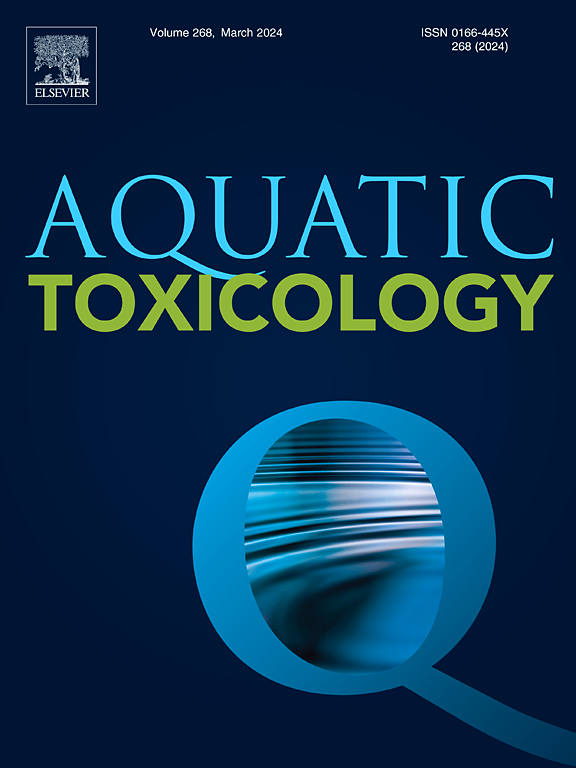整合大型蚤理化特性和毒代动力学时程数据的概念验证多层贝叶斯方法
IF 4.1
2区 环境科学与生态学
Q1 MARINE & FRESHWATER BIOLOGY
引用次数: 0
摘要
人们建议使用硅学和体外方法(通常称为新方法(NAMs))来支持环境(和人类)化学品安全决策,确保加强环境保护。为环境相关物种开发的毒物动力学模型是部署基于 NAMs 的安全战略的基础,可实现外部和内部化学品浓度之间的转换,但这些模型需要历史毒物动力学数据和强大的物理模型才能被视为可行的解决方案。大型水蚤是生态毒理学中的一个关键模型生物,但与大多数无脊椎动物一样,其定量毒物动力学数据有限且分散,因此缺乏可靠的毒物动力学模型。此外,目前的大型蜗牛模型是针对特定化学物质的,这限制了其适用范围。本研究的目的之一是通过收集涵盖广泛化学空间的大型蚤毒代动力学时程数据并评估数据集的独特性,来解决目前数据可用性的限制。经整理的毒物动力学数据集包括来自 17 项研究的 30 种化学物质的 48 个时间历程,并将其开发成一个名为 AquaTK 的 R 软件包。随后,我们开发了一个概念验证贝叶斯分析法,在三种不同的数据可用性情况下,以三种不同的精度水平从数据中估算出稳态浓度比(内部浓度/外部浓度),用于环境风险评估。具体而言,一项阿特拉津案例研究说明了多层次建模方法可在数据可用性不断增加的情况下改善(减少不确定性)浓度比的预测。我们的工作提供了一个一致且自足的贝叶斯框架,无论单个实验的层次或分辨率如何,该框架都能利用可用信息生成对大型蜗牛体内稳态浓度比的最佳预测。这种方法对于支持在环境风险评估中实施基于 NAMs 的环境安全范式转变至关重要。本文章由计算机程序翻译,如有差异,请以英文原文为准。
A proof-of-concept multi-tiered Bayesian approach for the integration of physiochemical properties and toxicokinetic time-course data for Daphnia magna
The use of in silico and in vitro methods, commonly referred to as New Approach Methodologies (NAMs), has been proposed to support environmental (and human) chemical safety decisions, ensuring enhanced environmental protection. Toxicokinetic models developed for environmentally relevant species are fundamental to the deployment of a NAMs-based safety strategy, enabling the conversion between external and internal chemical concentrations, although they require historical toxicokinetic data and robust physical models to be considered a viable solution. Daphnia magna is a key model organism in ecotoxicology albeit with limited and scattered quantitative toxicokinetic data, as for most invertebrates, resulting in a lack of robust toxicokinetic models. Moreover, current D. magna models are chemical specific, which restricts their applicability domain. One aim of this study was to address the current data availability limitations by collecting toxicokinetic time-course data for D. magna covering a broad chemical space and assessing the dataset's uniqueness. The collated toxicokinetic dataset included 48 time-courses for 30 chemicals from 17 studies, which was developed into an R package named AquaTK, with 11 studies unique to our work when compared to existing databases. Subsequently, a proof-of-concept Bayesian analysis was developed to estimate the steady-state concentration ratio (internal concentration / external concentration) from the data at three different levels of precision given three different data availability scenarios for environmental risk assessment. Specifically, an atrazine case study illustrates the multi-level modelling approach providing improvements (uncertainty reductions) in predictions of ratios for increasing amounts of data availability. Our work provides a consistent and self-contained Bayesian framework that irrespective of the hierarchy or resolution of individual experiments, can utilise the available information to generate optimal predictions of steady-state concentration ratios in D. magna. This approach is paramount to supporting the implementation of a NAMs based environmental safety paradigm shift in environmental risk assessment.
求助全文
通过发布文献求助,成功后即可免费获取论文全文。
去求助
来源期刊

Aquatic Toxicology
环境科学-毒理学
CiteScore
7.10
自引率
4.40%
发文量
250
审稿时长
56 days
期刊介绍:
Aquatic Toxicology publishes significant contributions that increase the understanding of the impact of harmful substances (including natural and synthetic chemicals) on aquatic organisms and ecosystems.
Aquatic Toxicology considers both laboratory and field studies with a focus on marine/ freshwater environments. We strive to attract high quality original scientific papers, critical reviews and expert opinion papers in the following areas: Effects of harmful substances on molecular, cellular, sub-organismal, organismal, population, community, and ecosystem level; Toxic Mechanisms; Genetic disturbances, transgenerational effects, behavioral and adaptive responses; Impacts of harmful substances on structure, function of and services provided by aquatic ecosystems; Mixture toxicity assessment; Statistical approaches to predict exposure to and hazards of contaminants
The journal also considers manuscripts in other areas, such as the development of innovative concepts, approaches, and methodologies, which promote the wider application of toxicological datasets to the protection of aquatic environments and inform ecological risk assessments and decision making by relevant authorities.
 求助内容:
求助内容: 应助结果提醒方式:
应助结果提醒方式:


